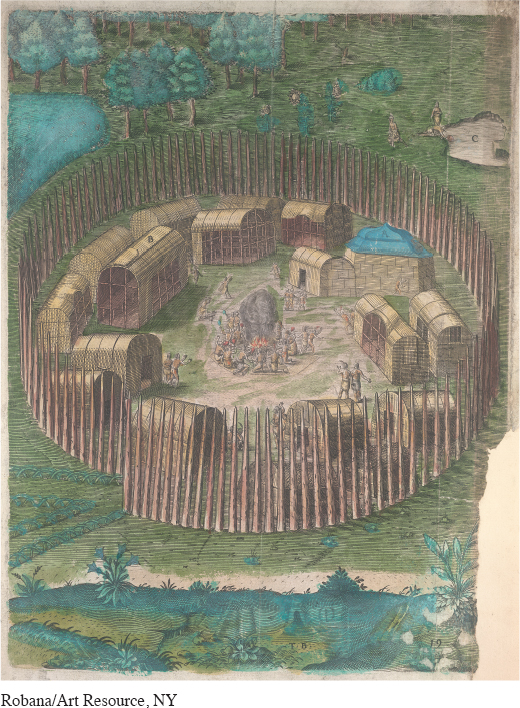The English Establish Jamestown
England’s success in colonizing North America depended in part on a new economic model in which investors sold shares in joint-stock companies and sought royal support for their venture. In 1606 a group of London merchants formed the Virginia Company, and King James I granted them the right to settle a vast area of North America, from present-day New York to North Carolina.
Some of the men that the Virginia Company recruited as colonists were gentlemen who hoped to get rich through the discovery of precious metals. Even more skilled artisans and laborers were recruited to launch the settlement, though many of them also hoped to become wealthy. Arriving on the coast of North America in April 1607, the colonists established Jamestown on a site they chose mainly for its easy defense. Although bothered by the settlement’s mosquito-infested environment, the colonists variously focused their energies on constructing buildings, producing food, and searching for gold and silver.
The Englishmen quickly made contact with the Indian chief Powhatan. He presided over a confederation of some 14,000 Algonquian-speaking Indians from twenty-five to thirty tribes, which surrounded the small Jamestown settlement. The Powhatan Confederacy was far more powerful than the English settlers, and, indeed, for the first two years the settlers depended on the Indians to survive. A shortage of food, caused by a severe drought between 1606 and 1612, affected both Indians and the English. It was exacerbated in Jamestown by some colonists’ refusal to engage in manual labor. Moreover, the nearby water was tainted by salt from the ocean, and diseases that festered in the low-lying area killed more than half of the original settlers.

Despite the Englishmen’s aggressive posture, Powhatan assisted the new settlers in hopes they could provide him with English cloth, iron hatchets, and even guns. His capture and subsequent release of John Smith in 1607 suggests his interest in developing trade relations with the newcomers even as he sought to subordinate them. But leaders like Captain Smith considered Powhatan and his warriors a threat rather than an asset. When unable to feed themselves that first year, Jamestown residents raided Indian villages for corn and other food, making Powhatan increasingly wary. The settlers’ decision to construct a fort under Smith’s direction only increased the Indians’ concern.
Meanwhile the Virginia Company devised a new plan to stave off the collapse of its colony. It started selling seven-year joint-stock options to raise funds and recruited new settlers to produce staple crops, glassware, or other items for export. Interested individuals who could not afford to invest cash could sign on for service in Virginia. After seven years, these colonists would receive a hundred acres of land. In June 1609, a new contingent of colonists attracted by this plan—five hundred men and a hundred women—sailed for Jamestown.
The new arrivals, however, had not brought enough supplies to sustain the colony through the winter. Powhatan did offer some aid, but Indians, too, suffered from shortages in the winter of 1609–1610. A “starving time” settled on Jamestown. By the spring of 1610, seven of every eight settlers who had arrived in Jamestown since 1607 were dead.
That June, the sixty survivors decided to abandon Jamestown and sail for home. But they changed their minds when they met three English ships in the harbor loaded with supplies and three hundred more settlers. Emboldened by fresh supplies and an enlarged population, Jamestown’s new leaders adopted an aggressive military posture, attacking native villages, burning crops, killing many Indians, and taking others captive. They believed that such brutality would convince neighboring tribes to obey English demands for food and labor.
Exploring American HistoriesPrinted Page 47
Exploring American Histories Value EditionPrinted Page 36
Chapter Timeline